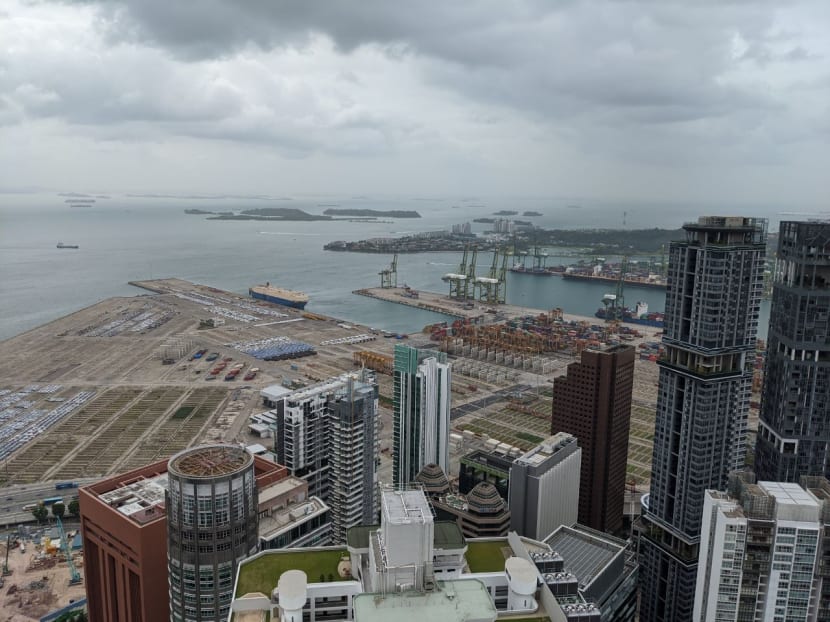New prime area housing model could fuel demand for nearby units without the same restrictions, say analysts

A view of the Tanjong Pagar Terminal in 2019, which forms part of the Greater Southern Waterfront. (Photo: Cheryl Lin)
SINGAPORE: A new model of public housing in prime locations – with stricter resale conditions – could drive demand for other units in nearby areas that are not subject to the same rules, said analysts.
This comes after authorities announced on Wednesday (Oct 27) that buyers of future Build-to-Order (BTO) flats in prime areas will face a longer minimum occupation period (MOP) of 10 years before they are allowed to sell the unit on the open market.
Other conditions under the Prime Location Public Housing (PLH) model include a subsidy clawback upon the sale of the unit, and not being able to rent out the entire flat, even after the MOP has been fulfilled.
It will apply to certain Housing & Development Board (HDB) projects in central locations, such as the city centre and surrounding areas, including the Greater Southern Waterfront. The first such project will be launched in Rochor next month.
BUMPING UP DEMAND FOR OTHER FLATS
Analysts CNA spoke to said the moves are a step in the right direction to curb the “lottery effect” and promote inclusiveness in prime areas.
But they added that the tighter rules could have the unintended impact of driving demand for flats in nearby areas, which do not face the same rules.
“These kinds of older flats or previous launches are not affected by this – owners can still sell them in five years, sublet it out. Definitely for those looking for future rental returns or capital appreciation gains, they will probably look for these homes,” said Dr Lee Nai Jia, Deputy Director of the Institute of Real Estate and Urban Studies (IREUS) at the National University of Singapore.
“They will also know that in future, there will not be any such products in the market, especially in the city centre area. So I think definitely demand and pricing will see some spike,” said Dr Lee.
But he added that buyers will have to be mindful of the length of the remaining leases on some of these older units.
While ERA Realty’s head of research and consultancy, Nicholas Mak, agreed that demand would spill over to surrounding areas, he said prices are unlikely to go up significantly.
“The overall stock of HDB flats in that location will increase with the completion of the PLH flats. Based on economic theory, an increase in supply can moderate the rise in prices.
“Hence, any increase in the resale prices of the non-PLH flats will still depend on other major factors, such as the state of the economy, household income, market conditions and government intervention,” said Mr Mak.
Buyers may also possibly turn their attention to mature estates which are not in prime areas, said experts. But even then, any such impact may not be seen immediately.
“This is more in the long run once more properties are constructed and these measures come into play,” said Mr Mohan Sandrasegeran, a research analyst at property firm Ohmyhome.
In the meantime, he suggested putting in place a proper criteria and clear definition of prime areas to avoid “any contest of the new rules” in future.
“One thing is the definition of prime area and what qualifies it to be – for example, the closeness to the MRT station?”
IMPACT OF 10-YEAR MINIMUM OCCUPATION PERIOD
Authorities have also doubled the MOP for these units to 10 years, a move aimed at weeding out speculative buyers.
But experts also noted that this could cause inconvenience for buyers whose circumstances change over time, such as families who have children and decide they need more space. National Development Minister Desmond Lee said that appeals by those who genuinely face extenuating circumstances will be reviewed on a case-by-case basis.
Mr Mak also pointed out that this extended MOP may lead to less liquidity in the market, as more buyers will be locked into their home purchases for a longer period.
He added that if the proportion of PLH flats out of total BTO supply rises over time, it would also slow HDB upgraders’ demand for private properties.
SUBSIDY CLAWBACKS AND INCOME CEILING
The extent of subsidy clawbacks will be revealed at the launch of the Rochor BTO project next month. The clawback will apply regardless of when the flat is resold in the future.
Huttons’ head of research Lee Sze Teck estimated that this clawback will be between 3 per cent and 5 per cent of the resale price.
Besides this clawback, there will be a S$14,000 income ceiling for prospective buyers.
Together with the current mortgage servicing ratio of 30 per cent, which is the limit on how much you can borrow when you take a loan to buy an HDB flat, an artificial price ceiling on PLH flats will be created, said Mr Lee.
Given the limited gains to be made, IREUS’ Dr Lee said that this might sift out the buyers who are looking to buy an HDB “as a platform to move to something else”.
BROADER PUSH FOR MINDSET SHIFT
The new model is also significant because it sends a strong signal about the purpose that HDB flats should serve, said experts.
“The Government has been trying to emphasise that HDB flats are a home for life and not an investment tool itself, and the message for flats in the PLH area reinforces that.
“Hopefully it can create a mindset shift for some HDB buyers,” said Huttons’ Mr Lee.
ERA’s Mr Mak echoed that the model aims to move the needle on the long-standing issue.
In addition, IREUS’ Dr Lee called the model a “bold” move that will also help shape the identity of the precinct, by making people live there for longer.
“In some areas, you see a lot of resale activity - it’s very disruptive to the families that move. Second thing is when they move, certain social networks are broken. So (it will be) very difficult for the precinct to develop identity or social camaraderie.”
While singles are excluded from this project, Dr Lee added that they may be included in future when the PLH is extended to more areas, given Singapore’s changing social fabric.








